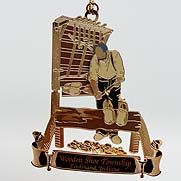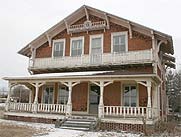2009 Essays: Honorable Mention — The Great Depression by Morgan Blessinger
The church bells ring out loud. The sun shines brightly. The seats fill up fast. The music starts, and the bridesmaids walk down the aisle with the groomsmen. Then the famous song comes on announcing the bride’s entry. Stares and whispers erupt through the crowd. A wide smile spreads across the bride’s face. This moment has finally arrived, and the day shows perfection. Could this possibly take place during the Great Depression?
The Great Depression hit every town in the United States, even little Ferdinand, Indiana. Dubois County hurt from the depression because of all the farms. According to Irma Dilger, a resident of Ferdinand, Cletus Kersteins commented, “We don’t have anything, and we aren’t getting anything”–a line he would say to his family every single night. Cletus received nine cents for a dozen of eggs and eleven dollars a hog. Their family had food because they lived on a farm. (Dilger)
Couples put off getting married during the Great Depression. Divorce rates dropped dramatically simply because the payment of legal fees and providing for another household cost too much. Birthrates also dropped. (America 1) The Depression did not keep all weddings from happening. Few local couples put off weddings in this area. All prices rose in expense due to the Depression, causing everyone’s weddings to cost the same. (Dilger)
Back then, people traditionally had big weddings and stuck to that (Mathews 3). The mass, which started at 7:30 a.m. or 8:00 a.m., and the reception lasted a full day and always occurred on a Tuesday. Talk went around if someone got married on a Saturday because folks did not like Saturday weddings since they went to church the next day. (Dilger) Matilda and Lawrence Loechte defied tradition and had one of the first weddings on a Saturday; the wedding mass still began at 8:00 a.m. After mass, family members served breakfast at the bride’s house. Dinner followed usually around noon. A barn dance consumed the afternoon with mostly leftovers eaten for supper. Then they arranged for a dance for anyone at the nearest dance hall. (Fest 383-384) The wedding party lasted until after midnight (Mathews 3).
Irma Kersteins and Ted Dilger first saw each other at Sonderman’s Store. He called her and Irma went as his date to a wedding. She received her engagement ring from Ted in December making them engaged. Since they planned to marry in August, she told her mother right away. With family and neighbors, they made the wedding plans: food, flowers, and locations. The parents of both Ted and Irma split the payments for the wedding. Putting aside her money for the wedding, Irma worked in Louisville doing housekeeping and earned six dollars a week that she mailed home. (Dilger)
The wedding mass occurred on a Tuesday at 7:30 in the morning (Dilger). According to Garret Mathews, the day consisted of a “sit-down breakfast, a sit-down lunch, a sit-down supper, an afternoon dance at the granary and an evening dance at the Woodman’s Hall.” The neighbors made all the meals. For drinks, the Dilger’s made their own “homebrew beer”. “Pretzels, cigars, sodas, wine, barrel beer and bootleg whiskey” lined the Kersteins’ house. (Mathews 3) The wedding party took pictures between breakfast and lunch. After lunch, the guests had a barn dance. Throughout the afternoon and evening, the Denning Band played. Supper took place at the Kersteins’ home as the earlier events did. Once supper ended, all the people from the town danced their way into Woodman Hall. Everyone came to the free dances, unlike nowadays. (Dilger)
Irma bought her wedding dress from a store for thirty-nine dollars. Her flowers amounted to five dollars a bouquet, a price that her dad thought ridiculous. The cost of the flowers surprised her most because nothing else in the wedding cost more. (Dilger) According to Irma Dilger, “Everything was actually high-priced at that time.” The expenses for the wedding follows: two barrels of Cook’s beer – $14.75 a barrel with a twelve dollar refund per barrel when returned, three hundred pounds of ice for $1.50, $.70 for thirty- two cases of soda, $11.00 for bootleg whiskey, $17.62 for one hundred and thirty- three pounds of beef, $10.00 for ten gallons of ice cream, $2.80 for thirty-five loaves of bread, $1.75 for thirty-five pounds of sugar, $1.35 for twelve cans of peas, $8.00 for bride’s bouquet, another $8.00 for two bridesmaids’ flowers, $3.00 rental for Woodman Hall, $10.00 for the Denning Band, $1.00 for chewing gum, ribbons for $.60, $1.02 for eggs, $.80 for powdered sugar, cake trimmings for $.47, pretzels for $.87, lemons for $.75, bologna for $.30, and $2.75 for cigars. The final bill totaled $137.70. (Mathews 3) Irma’s parents had kept the wedding receipts. They gave them to her, and said she could do anything she wanted. She just held onto all of them. (Dilger) While cleaning one day, she discovered the receipts. “All the prices looked ridiculous, but I was probably most amazed by what the flowers cost in 1938,” stated Irma Dilger. (Mathews 3) The receipts will turn seventy-one years old this coming August (Dilger).
Weddings today have reached astronomical proportions. Back in the day, “simple” weddings took place at home, but now weddings give families a chance to show wealth. According to author Elizabeth Hilts, “One couple touted on Oprah spent over seven million dollars on their wedding.” When asked about weddings today, Irma Dilger commented by saying, “Everyone wants their wedding a little better than someone else’s. There are wedding planners now. We didn’t pay for food. It was all volunteer work. We did the same for everyone in the neighborhood.” She does not believe they need to last a whole day because “it was too long and tiring, and it would be even more expensive now.” Irma stated that she would not want a wedding as elaborate. (Dilger)
To keep a wedding within budget, people cannot fall into the pressures of society. Having the ability to remain cheap, green weddings, a growing trend, use environmentally friendly solutions. According to Sasha Souza of The Whole Shebang, a wedding planning business, in Pleasanton, CA, “It is possible to have a truly wonderful and green wedding.” These weddings use recycled or recyclable items, as well as “vegetarian foods, car pooling, a garden setting, cloth napkins and no Styrofoam.” According to Carol Reed-Jones of the Paper Crane Press, “A green wedding–Earth-sensitive, affordable, healthy, safe, and inclusive – and provides valuable information about how to plan one.” Hemp clothing is a popular trend or wearing a wedding dress worn before by a member of the family. (Hilts 1-2) Many differences come to the forefront of changing weddings. Caterers prepare wedding meals now, while neighbors no longer help cook or plan anything for the wedding. Families take care of all the wedding plans. The music and dancing have changed dramatically. Receptions can happen at a variety of places, and weddings do not even have to take place at a church anymore. What a wedding means has altered through the years. Back then, a person gave his or her life-long commitment to a spouse. (Fest 385) Couples had much more commitment for each other; divorces never happened, and in some cases, couples stayed together because divorce was frowned upon. People rarely had kids out of wedlock. (Dilger) Today, spouses still possess a commitment, but not always a permanent one. Almost over half of marriages now come to divorce in the United States. (Fest 385) According to one website, “a survey showed that 1.5 million married women had been abandoned by their husbands during the depression.” This caused the role of women to change during the Depression; for example, women had a say in making decisions of the home due to their new employment. They had a higher status and more power in the family. (America 2)
Weddings and marriages will not end, but traditions will. Customs fade over time, just as the “simple” wedding did. Holding the potential of staying within reason, weddings do not have to give in to the pressures of society. Huge blowouts do not prove the marriage will stay strong or last long. Marriage and the life-long commitment that is given and received is the focus of the wedding, not the decorations or food. Money cannot buy happiness.



